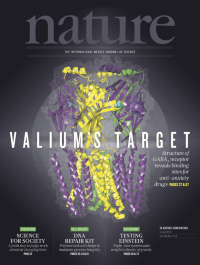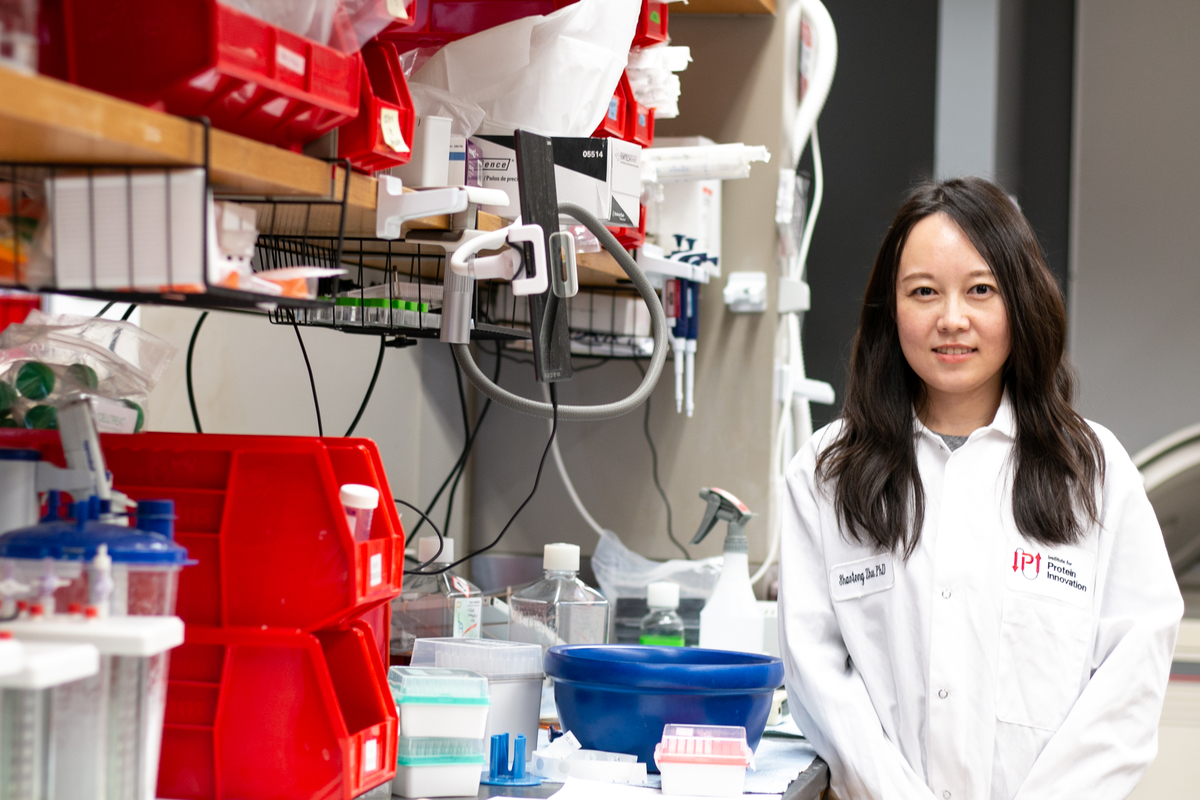Shaotong Zhu’s face lights up when she talks about a challenge. From bacterial enzymes to the notoriously complicated gamma-aminobutyric acid type A (GABAA) receptors, she has taken on some of the most difficult problems in structural biology — and solved them.
“Shaotong has a very strong background in structural biology of membrane proteins,” Rob Meijers, director of the Antibody Platform at IPI, says. “She proved that she is at the forefront of that field.”
Now, as the principal scientist heading IPI’s new Protein Research team, Zhu is applying her expertise in biochemistry and structural biology to develop antibodies to aid in answering critical biological questions.
As part of a collaborative National Science Foundation-funded project targeting the opioid receptor, Zhu is working to express the shape-shifting protein and develop antibodies that lock it into its most pain-receptive state. The findings from this study could help set the stage for the discovery of new painkillers with far less addictive potential.
At the same time, she is eager to tackle the expression of ancient cell signaling molecules, critical for embryonic development, and generate hard-to-reach functional antibodies. If successful, she will be able to shed light on diseases including cancer and diabetes, and provide the developmental biology community with a key scientific tool.
Searching for a challenge
This high-risk, high-reward style seems at odds with the personality that one might encounter upon meeting Zhu for the first time. She bears a quiet enthusiasm and steadfast confidence best illustrated by how she made her way to IPI.
As an undergraduate biology and English student at Southwest University in Chongqing — a city in China’s mountainous region exalted by Zhu for its spicy food and hot pot — Zhu was initially fascinated by literature and Western classics. She was active in the college writing community and thought after graduation she might become a journalist or a writer.
But in her junior year, she was recruited as a volunteer in the cell biology teaching lab. She spent days feeding cell lines, washing flasks and assisting during student experiments. Looking down at the cells, Zhu felt something click.
“I still remember I romantically thought, ‘Those creatures look tiny and fragile but have infinite possibilities in disease research. I will do my utmost to take care of them,’” she says.
She became more and more devoted to her research, spending long hours in the lab and feeling fulfilled through each small step of her project’s progress. She decided to pursue a Ph.D. in biology.
She landed a position with Steven Vik at Southern Methodist University in Dallas, Texas, studying the structural and functional mechanisms of bacterial Complex I, an enzyme essential for ATP synthesis. This was her first experience with membrane proteins, using biochemical tools to interpret the enzyme’s proton translocation mechanism. She was hooked.
A daunting receptor
Zhu continued on to a postdoctoral fellowship with neuroscientist and biophysicist Ryan Hibbs at the University of Texas Southwestern Medical Center (UTSW). The position was perfect — giving her the chance to gain expertise in structural biology while working on the GABAA receptor.
The GABAA receptor binds to GABA, the major inhibitory neurotransmitter, and is responsible for most of the fast inhibitory neurotransmission in the central nervous system. Dysfunction of the receptor is linked to neurological disorders and mental illnesses, including epilepsy, anxiety and insomnia. The GABAA receptor is also a known target of illicit, therapeutic and recreational drugs, including benzodiazepines, barbiturates, anesthetics, hypnotics and alcohol. No one had yet mapped the receptor’s structure, but Shaotong took the failure as an invitation.
“I followed my heart and told myself I would not come across half of the world to do something easy,” she says. “I wanted a challenge.”
She attempted to use X-ray crystallography to gain a blueprint for GABAA receptor’s architecture — but the neuroreceptor was too complex.
“It’s very hard to get the crystals,” Zhu says. “And even when you do, they don’t diffract well to get high-resolution.”
But two factors coincided to illuminate the structure.
Imaging a complex receptor
The late 2010s were a time of huge advance in imaging technology. As Zhu began her research, a technique called cryo-electron microscopy (cryo-EM), which beams electrons at flash-frozen proteins to capture three-dimensional images in never-before-seen detail, was sparking a “resolution revolution” in structural biology, even serving as the basis of the 2017 Nobel Prize in Chemistry.
During her postdoc work, Zhu purified the human GABAA receptor and used the cryo-electron microscope to capture it in hundreds of thousands of images. She then used software to compile structural snapshots from different angles to reconstruct the receptor in three dimensions.

But there was a catch: the GABAA receptor’s three subunit types were nearly identical.
This pseudo-symmetry meant the features of interest were indistinguishable by the data processor. The proteins could not be properly aligned, and the resulting reconstruction was in unsuitably low resolution. But Zhu was determined.
She raised monoclonal antibodies against the receptor and isolated the GABAA receptor-Fab complex, knowing that the antibody would bind only to the receptor’s alpha subunit, thereby aiding the data processor in aligning the snapshots. Then, Zhu took a look at the composite complex.
“The resolution was amazingly improved,” she says. “It was really a big change after adding the antibody.”
Zhu’s innovative approach had produced the first high-resolution structure of this important human brain receptor, published in Nature, handing key blueprint information to scientists looking for less-risky alternatives to benzos and other drugs.
Growing a Protein Research team
Searching for the next challenge, in August 2021, Zhu heard about the IPI in Boston. She learned the Institute, an atypical academic-industrial research entity, was searching for researchers with enough grit to take on difficult membrane proteins, large protein complexes and hard-to-generate antibodies.
In her first months as principal scientist, she’s built out the Institute’s new Protein Research lab and is now recruiting a research-focused team to hone in on the opioid receptor and tackle challenging protein targets for antibody development, including a key cell-signaling regulator that is conserved in many species — from flies to worms to humans. Antibodies to these important proteins could have enormous implications in human disease.
While excited by the clinical promises of her research, Zhu knows those ends are far off. She remains motivated by the beauty in the fundamental biological questions and in working methodically to unearth hidden molecular architecture — even when the work is painstaking.
“If you want to do science, you have to be patient,” she says, “and then just try to not easily give up.”
Writer: Caitlin Faulds, caitlin.faulds@proteininnovation.org
Sources: Shaotong Zhu, shaotong.zhu@proteininnovation.org;
Rob Meijers, rob.meijers@proteininnovation.org


